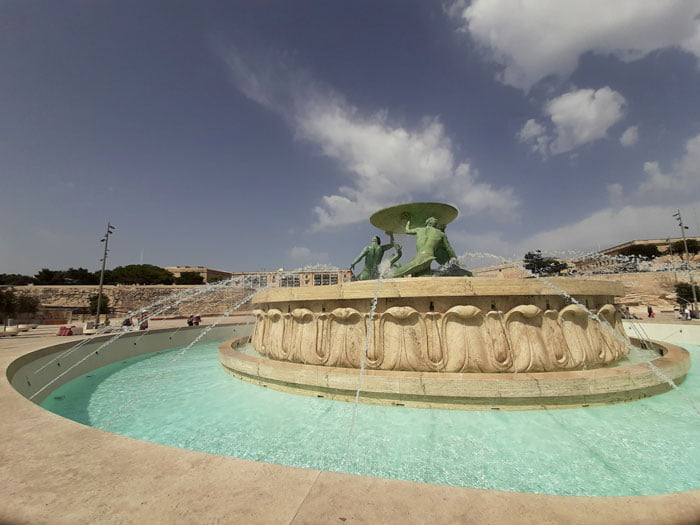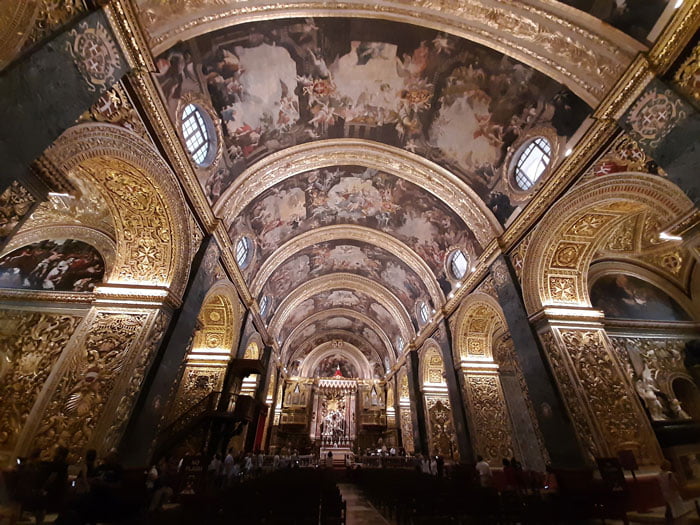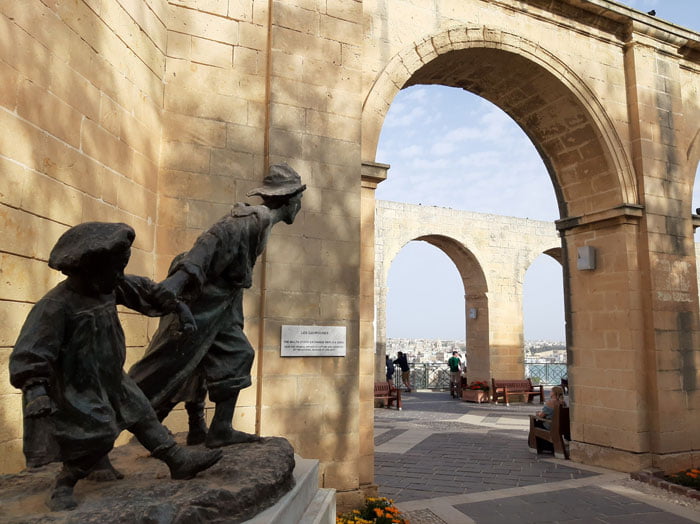
If you need a freelance travel writer or you would like to see your country, city, flight, etc., presented on the blog, drop me an email.
Find our more on Freelance Travel Writer page.
Why “Things to do in Valletta”? Well, Malta was not a destination I gave much thought to earlier, at least not before I visited the Old Town on Rhodes Greece. Not only it is well kept and still in use, but it was built by – the Maltese knights (or the knights of Rhodes who fled the island after the Ottoman invasion). I am not into “secret societies” or any kind of conspiracy theories and “great orders”, but I am always stunned by such historical monuments. Just imagine – the Malta capital wouldn’t be there if things happened differently! All those points of interest with the narrow streets of Valletta that separate buildings made of beige stone, various ornaments, and Baroque palaces, all of that sprung from the 16th century onward when the knights began their rule on the island.

This travelogue will naturally begin with things to do in Valletta, the town we rush to because of its authentic architecture, so many points of interest, and the atmosphere of its streets. (We will come to beaches and the sea in one of the upcoming series’ posts.) Still, let me share a few significant Malta details so that you can get a picture of the place we came to this time.

So, in the middle of the Mediterranean at about 90 km from Sicily and 290 from African shores, lies the small archipelago consisting of the main island of Malta, Gozo which is two-thirds smaller, and Comino island between the previous two. They stretch over 316 square km (compare to Belgrade Serbia which covers 360 or Rome Italy with 1,3), and its population is 410.000 (where Belgrade’s is 2 million and Rome’s is 2,9). The country has a stunning history, becoming part of the European Union back in 2004.

The first settlers are believed to be from Sicily and came 7,000 years ago. Phoenicians conquered the territory in the 8th century BC, Romans came in the 3rd BC, Byzantine army ruled from the 4th century AD, after they came the Arabs in the 9th century, Europeans in the 11th, knights of the Order of St. John in the 16th, then Napoleon ruled shortly in the 18th century, along came the British until Malta got its independence in 1964. The fascinating thing is that one is able to see monuments from all of these periods, while Maltese tradition embedded all the influences into one rich culture.

VALLETTA MALTA
Knights of Order of St. John asked the king Charles V of Spain and the Roman pope in 1523 to buy the island. Instead, in 1530 Malta was given to them. After the Great Siege and the victory over the Ottoman’s army in 1565 where knights played a crucial role, the Order asked their European counterparts to help them build numerous fortifications. Pope Pius V sent his own military architect Francesco Laparelli da Cortona and the first stone was laid in 1566. After the frantic work, the fort was erected with observation towers, followed by official palaces, hospital, residences for all the langues.
The town was named after the Grand Master Jean Parisot de la Valetta, French nobleman who lead the knights during the Great Siege. The knights ruled the island for 268 years during which various other buildings throughout the islands sprung up, fortresses and churches, while the population of 15,000 they found when they landed, rose to 100,000 at the end of the 18th century.

As soon as you approach the Triton Fountain, it’s immediately clear why Valletta is declared a UNESCO World Heritage Site. The main paved Republic Street is so vibrant with shops, restaurants, and café terraces on both sides, squares, and it goes all the way to Fort St. Elmo.

You will pass by the National Archaeology Museum, over Republic Square, St. George Square, next to the Grand Master’s house which now serves as the presidential palace, etc.

The one that you cannot afford to miss is the renowned St. John Co-Cathedral, located on the same street at the Great Siege Square. It’s open to public visits until 4 pm and the entrance fee is 10 Euros. They will check your belongings, you should be properly dressed (you are entering a church after all), and audio guides are available in various languages.

When Marina from Leona Travel (who helped me a lot when visiting Malta and who can organize tours in English, Italian, Serbian, etc.) told me that it will take two hours to go around the Cathedral, I was a bit suspicious. It turned out though that I almost twisted my neck looking up into the impressive ceiling and decorative niches of knights’ Langues, went from one room to another, blinded by all those golden ornaments, and that I didn’t even notice that it took me – two hours and a half!

The Cathedral was built in the 16th century, in 1576 to be precise, and represents a true monument of the knights’ Order. Visiting the Cathedral is among the things to do in Valletta. The floor is covered with picturesque marble panels that are actually the 400 tombstones of the former grandmasters. On both sides of the church, there are altars dedicated to different Langues and adorned by lavish ornaments, sculptures, gold, and many important canvases.

Those of you who are into art will be happy to hear that in the separate part called the Oratory there are two original Caravaggio masterpieces. They say that he even put his name in the painted blood on the Beheading of St. John the Baptist. This canvas is considered to be one of the most important early Baroque work.

Michelangelo Merisi da Caravaggio is born near Milan in 1571. He worked in Rome where he was forced to escape from in 1606 because he killed a local pimp in a fight. That is when his journey to Naples, Sicily, and Malta begins. Here, he became the knight himself, but he was soon kicked out of the Order. The story says that yet in another fight he killed a second man, that he was locked up, but managed to escape and secretly went back to Sicily and Naples. This is where he was caught up by the Maltese when the great artist got seriously wounded and died. The other version says though that he got malaria on the outskirts of Rome, the city he was trying to go back to his whole life.

The Cathedral ceiling was painted by Mattia Preti, along with a few side Langues’ paintings. Going from one niche to another, I stumbled across an interesting restoration site – the man was working on parts of the wall standing on the small hoist while the statue of one of the slaves holding the grand master’s pedestal, was “looking up” straight at him. There are three clocks on the Cathedral façade, showing different times. They say that all the churches in Malta usually have two of those, “in order to confuse the enemy”.

Marina also says that there are 365 churches in Malta, “one for each day”. With such imposing Catholic tradition, no wonder that one can come across another beige Christian temple at almost every corner.

Make sure to take a walk along numerous side streets in Valletta. Mine took me all the way down Republic Street, where I bought the traditional pastizzi pastry (available with cheese or peas and chicken – I even had a Kinder pastizzi in Gozo, I’ll tell you all about it when we get there in the series). This pastry is more than affordable – two of those with a small bottle of water were two Euros. If you want to have lunch or a coffee, there is a variety of places to choose from in surrounding streets (Merchant Street being one), offering some delicious seafood. At the beginning of Republic Street, you can also indulge in Lebanese falafels. When it comes to photographs, the medieval arches of Old Theater Street will be the inexhaustible site of inspiration.

On the outer Valletta walls facing the Three Cities, there are two gardens with magnificent views. The Lower Barrakka Garden is near Fort St. Elmo and it overlooks the entrance to the Great Harbor. You will see numerous benches, a small Greek temple, various arches, and a watch tower with a huge bell that rings every day at noon.

It’s not far to take a walk towards the Upper Barrakka Garden. They say that this is where one of the most impressive harbor views anywhere in the Mediterranean is to be seen. You can appreciate the Three Cities and Fort St. Angelo. The Phoenician temple is believed to be there at the same spot the fortress occupies now, while the place was the Grand Master’s main headquarters during the Great Siege.

(All of you GOT fans, listen up – the Fort St. Angelo is the place where the scene with Arya chasing cats through Red Keep’s dark corridors and overhearing secret conversation was filmed. I will include other filming locations in Malta when we get to those places in the blog series, so try not to miss it!)

Beneath the balcony, there are 19th-century guns that are firing every day at noon. Over at one side, you can see the small restaurant terrace overlooking the reddish dome of the Notre Dame de Liesse church. If you came on foot along the wall towards this garden, you are actually walking above the waterfront where the fish market and craftsmen shops once were.

Coming out of the garden, I made the full circle and ended up at the Triton Fountain again. Make sure to notice the palace with few steps and two cannons in front of it and here is why. The knights used to be organized in eight Langues according to their languages. Each of them had its own hostel or auberge. Seven of them were in Valletta and it’s possible to see five nowadays. The Auberge of Provence is, for instance, housing the Archaeology Museum. Still, the most impressive one is the auberge of Castile that we are looking at. This is where the Malta prime minister’s office is today.

Just behind the corner is the so-called Palazzo Pariso, another lush building. Napoleon Bonaparte spent a week here when the French took over the city. The Maltese Foreign Ministry uses these premises today.

I bought a guidebook right at Republic Street (it’s always a great souvenir) and I remembered that Marina mentioned the Great Harbor Cruise. There’s no better way to see all those stunning fortifications, even though you can’t really tell the difference at first. The boat takes off from the Sliema district and you can take the bus to get there. It’s possible to have something to eat while waiting to go on board. And then you will hear interesting stories about these heavy beige walls that go by. (The Fort Manoel terrace was the place where the dramatic GOT scene of beheading Eddard Stark was filmed.)

For instance, they say that marsa in Maltese means harbor. Given the similar historical roots, one can notice that there is an Italian port called Marsala or the French one – Marseille. The second largest catamaran in the world is to be seen here, the one that only needs 90 minutes to get to Sicily. Great cruisers that accommodate 4,000 people sail into the Great Harbor every week. They are ridiculously huge, much taller than the city walls, while our small boat couldn’t even reach its line of the first underfloor storage windows. Such a silly clash of contemporary life and historical heritage.

This is where a few sentences should be added related to public transport which is a huge thing in Malta. I was offered at Supreme Travel to take the open bus that covers the whole island in two lines, costs 20 Euros per line and I can hop on and off as much as I want to. Buses go every 30 minutes from all the stations. (I have also heard that the other open bus company is not so reliable.) Still, given the fact that I travel a lot and love to immerse myself in local life as much as I can, it seemed more interesting to take the public transport ticket for seven days (Tallinja Explore card, 21 Euro). Why would I waste time on waiting for open buses for half an hour, right? Wrong!

Here is what happened. Little did I know that even though the public transport buses are air-conditioned and fairly new, with tickets being checked at or bought from the driver (1,5 or 2 Euros during summer per single ride), there is a machine telling you which station you are at, the mobile app and the specific timetable at every station – it only works in theory! None of the buses is on time and they go every 20, 30 and 60 minutes, so you can forget about that timetable. If you come to the bus station 10 minutes before the bus should (that goes every 60 minutes), and it passed by five minutes earlier, you are going to be stuck there for more than an hour. Also, if the driver decides that there are enough passengers inside, the bus will not stop at any more stations on the way until a few people come out. (Just imagine waiting for the bus for an hour and it just goes by!)

One more thing! The bus doesn’t stop either if someone doesn’t press the stop button inside which signalizes the driver that people want to get off. Also, if no one is getting off at the specific station, then people waiting for the bus have to wave to the driver. Otherwise, he will just drive away.

Should I tell you that I was waiting for the bus at the very airport when I landed – for the whole hour because I didn’t know I was supposed to wave while being at the station, or that one day I wasted more than three hours just waiting for different buses and trying to tour the island! I even went on foot once, when it turned out that the bus went earlier than it was scheduled and it was the last one, it didn’t go after 8 pm. I managed to get near my Airbnb in San Gwann (Marina was my host), but then I got totally confused. Luckily, an older Maltese gentleman was kind enough to drive me the rest of the way.

So, for all of you planning a trip to Malta who doesn’t want to take taxis all the time or rent a car (and try your skills in driving the left side), my warm recommendation is to take that open bus for tourist tours – at least you won’t wait more than 30 minutes. Nevertheless, as much as it’s true that I wasted hours waiting for public buses while being in Malta for five days, the fact is that every time somebody asked me last week “how was Malta”, the second thing I said started with: “And you should see their public transport, oh my!”
Next: MDINA, THE SILENT CITY
The full MALTA series

If you need a freelance travel writer or you would like to see your country, city, flight, etc., presented on the blog, drop me an email.
Find our more on Freelance Travel Writer page.
I am looking forward to working with you.




26 responses
Realistic and very informative! Well done!????????
Thank you, so glad you like it! :)????
Malta has not been on my radar either, but recently I have seen a couple of blog posts from people who recently visited and it looks beautiful. I actually would want to visit in the winter as Greece is just TOO hot in the summer 🙂
Malta is also too hot in the summer, especially in July and August, so it would be wise to go off the season. It’s worth a visit though, the country is pretty specific in so many ways.
Thanks! 🙂
I have heard of a lot of people going to Malta, but it hasn’t fully been a place where I have to go. It looks really awesome and has a ton of history and changing of hands. I would love to check it out one day.
That history actually made me visit, even though it wasn’t really on my radar. But it’s definitely worth it. 🙂
Malta is incredibly gorgeous, I love learning more about the history of the places I visit and would love to go back to Malta!
Well, I usually spend more time running around trying to see and learn more, instead of laying on the beach. I could definitely go there for a vacation. 😀
Haha, what a misadaventure! I’d probably end up doing the same thing, not waving down the driver for the bus to stop. A little culture shock to be sure 🙂 Great inclusion of the historical facts about Valleta Malta too – as a history buff I love reading about the origins and happenings of the past. It makes the place that much more vivid and interesting. I’m sure I’ll end up in Malta someday and I’ll take your guide to heart 🙂
As one history buff to another – try to visit Malta. 😉 Sure, there are beaches and the sea, as in any other island, but the atmosphere in Valletta or Mdina (the next post) is really like a step back in time.
Thanks, Adonis. 🙂
LEPO I NEOBIČNO SVAKAKO PRIJATNO
Hvala najlepše. 🙂
Malta is definitely moving up on our travel wish list. I am reading so many blog posts that are teasing me to explore Valletta and beyond. Your pictures certainly show why Valletta was declared a UNESCO World Heritage Site. So great that all of the different periods of this city are still represented in the architecture and art. Fascinating to read that there is a different church for each day of the year! Thanks for the warning about public transit. We might stick to the open top buses!
If you like Valletta, make sure to stop by the next post on Mdina and Rabat, because those towns are what Malta was through history. I just love such places, like fairy tale villages. <3
Thanks, Linda, would love to hear your impression on Malta if you decide to go. 🙂
Malta has such a fascinating history and so many interesting buildings. Impressed that a town of its size can support 365 churches. That Cathedral is spectacular.
Yes, can you imagine! 🙂 At first, every time you see a charming, beige church, you stop and take numerous pictures, and you do that after the second one, the third etc. By the time you reach the tenth, you stop noticing! 😀
Great tradition though. Loved those “small” details about the country. <3
Malta hasn’t been on my travel wish list, but it looks like such an interesting and lovely place to visit. Old historical places like this are always fun to experience, although public transportation can be confusing and frustrating. Valletta looks like a beautiful place to explore. I think I would take the boat tour just for all of the stories.
The harbor cruise is really pleasant. It lasts for an hour and a half and you get to see all the fortifications from another angle. It’s totally different when you actually climb those walls.
Thank you, Kathleen. 🙂
I loved the public buses in Malta – didn’t mind the wait and enjoyed the convoluted routes! I love St Georges Square for people-watching and Fort St Angelo for the views! Great guide!
I know, these places are so charming, right! It’s almost impossible not to enjoy Valletta.
Thank you! 🙂
What a beautiful place to visit. You had me at triton fountain. Malta is so beautiful
Thank you, so glad you like it. 🙂
Malta is one of my favourite trips Ever! We stayed in Valletta at Excelsior. It was quite a bit of a walk from everything but still a great hotel. (Not sure why every letter is getting capitalised in my comment as I write it). we took a tour of Game of thrones locations with a former cast member who gave us fun details about things that happened on the set. The youTube video I did of our trip on things to do in malta is one of my top performing videos! like you, it wasn’t high on my travel list until i went and saw how beautiful it was. Loved all the historic information you included!
Hey! Thank you, so nice of you to stop by.
Yep, I know what you mean, I loved the island for so many reasons. Feel free to browse around the whole series, there are three more articles on what to see and do in Malta.
Thanks, I’ll have to check out that video of yours. <3
Most what i read online is trash and copy paste but i think you offer something different. Keep it like this.
Hey, thank you. So nice of you to say that. 🙂